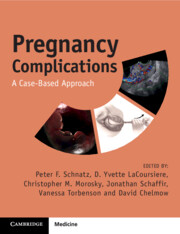Book contents
- Pregnancy Complications
- Pregnancy Complications
- Copyright page
- Contents
- Contributors
- Preface
- Note from the Editor-in-Chief
- Normal Laboratory Values (Conventional Units) []
- Section 1 Antepartum (Early Pregnancy)
- Section 2 Antepartum (Mid-trimester)
- Section 3 Antepartum (Late Pregnancy)
- Section 4 Antepartum (Medical Complications)
- Section 5 Antepartum (Infectious Complications)
- Section 6 Intrapartum/Delivery
- Section 7 Postpartum
- Section 8 Fetal Complications
- Section 9 Placental Complications
- Section 10 Complications of the Cord, Amnion, and Gravid Uterus
- Section 11 Psychosocial Considerations
- Case 90 A 40-Year-Old at 24 Weeks’ Gestation Presents with Food and Housing Insecurity
- Case 91 A 30-Year-Old at 25 Weeks’ Gestation Presents after a Fall with Back Pain and Bruising
- Case 92 A 25-Year-Old at 29 Weeks’ Gestation Presents with Opioid Use Disorder and Nausea, Vomiting, and Abdominal Pain
- Case 93 A 35-Year-Old Somali-Speaking Patient at 40 Weeks’ Gestation Presents in Active Labor with Her Husband as Her Interpreter
- Case 94 A 25-Year-Old Presents 1 Week after a Cesarean Delivery with Erratic Behavior
- Case 95 A 30-Year-Old Presents for a First Prenatal Visit with a Previous Emergency Operative Delivery Requesting a Planned Primary Cesarean
- Case 96 A 26-Year-Old Presents Late to Prenatal Care with Her Partner and Has a Flat Affect and Limited English Proficiency
- Case 97 A 25-Year-Old Primigravida with a History of Female Genital Mutilation
- Index
- References
Case 92 - A 25-Year-Old at 29 Weeks’ Gestation Presents with Opioid Use Disorder and Nausea, Vomiting, and Abdominal Pain
from Section 11 - Psychosocial Considerations
Published online by Cambridge University Press: 08 April 2025
- Pregnancy Complications
- Pregnancy Complications
- Copyright page
- Contents
- Contributors
- Preface
- Note from the Editor-in-Chief
- Normal Laboratory Values (Conventional Units) []
- Section 1 Antepartum (Early Pregnancy)
- Section 2 Antepartum (Mid-trimester)
- Section 3 Antepartum (Late Pregnancy)
- Section 4 Antepartum (Medical Complications)
- Section 5 Antepartum (Infectious Complications)
- Section 6 Intrapartum/Delivery
- Section 7 Postpartum
- Section 8 Fetal Complications
- Section 9 Placental Complications
- Section 10 Complications of the Cord, Amnion, and Gravid Uterus
- Section 11 Psychosocial Considerations
- Case 90 A 40-Year-Old at 24 Weeks’ Gestation Presents with Food and Housing Insecurity
- Case 91 A 30-Year-Old at 25 Weeks’ Gestation Presents after a Fall with Back Pain and Bruising
- Case 92 A 25-Year-Old at 29 Weeks’ Gestation Presents with Opioid Use Disorder and Nausea, Vomiting, and Abdominal Pain
- Case 93 A 35-Year-Old Somali-Speaking Patient at 40 Weeks’ Gestation Presents in Active Labor with Her Husband as Her Interpreter
- Case 94 A 25-Year-Old Presents 1 Week after a Cesarean Delivery with Erratic Behavior
- Case 95 A 30-Year-Old Presents for a First Prenatal Visit with a Previous Emergency Operative Delivery Requesting a Planned Primary Cesarean
- Case 96 A 26-Year-Old Presents Late to Prenatal Care with Her Partner and Has a Flat Affect and Limited English Proficiency
- Case 97 A 25-Year-Old Primigravida with a History of Female Genital Mutilation
- Index
- References
Summary
Substance use disorders are a major risk factor for maternal mortality, and opioid overdose is a leading cause of maternal mortality in several states. Pregnant and postpartum patients should be assessed for substance use disorders using a validated screening tool, and if present, should be managed with counseling, initiation of pharmacotherapy, and referral for ongoing treatment. Acute presentations of opioid intoxication and opioid withdrawal should be identified and treated. The recommended treatment of opioid use disorder in pregnancy is pharmacotherapy using an opioid agonist. Either buprenorphine or methadone may be appropriate, depending on patient preferences and available treatment resources. Patients should receive education on recognition and prevention of opioid overdose and a prescription for naloxone for overdose reversal.
- Type
- Chapter
- Information
- Pregnancy ComplicationsA Case-Based Approach, pp. 289 - 291Publisher: Cambridge University PressPrint publication year: 2025

